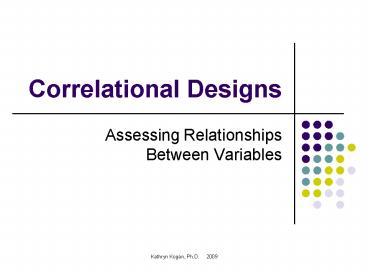Correlational Designs PowerPoint PPT Presentation
1 / 13
Title: Correlational Designs
1
Correlational Designs
- Assessing Relationships Between Variables
2
Correlational Designs
- A type of research that tries to discover and
describe relationships between naturally
occurring variables. - A type of descriptive research describes
relationships. - Variables are measured, not manipulated
- Is there a relationship between height and
weight? - Is obesity related to depression?
- What are the risk factors for ADHD?
- Surveys are one type of correlational research.
3
Correlational Designs
- Allow psychologists to detect when variables vary
in relation to one another, or co-vary. - Enable predictions to be made
- Allow us to predict the value of a variable based
on knowing the other (correlated) variable. - Utilize a correlation coefficient to express
the strength and direction of the relationship
between two variables. - Can be used to explore relationships and patterns
among multiple variables.
4
The Correlation Coefficient
- The correlation coefficient statistic r
indicates the strength (and direction) of a
relationship between two variables. - r ranges from 0.00 to or - 1.00
- 0.00 indicates no correlation, or 1.00
indicates a perfect relationship (strongest
possible).
5
(No Transcript)
6
Examples of Research Questions that would need a
Correlational Design
- Is amount of time spent watching commercial TV
associated with increased aggression in children? - Is hormone replacement therapy associated with
lowered risk of Altzheimers Disease? - Is access to positive role models in the
community associated with better teens
adjustment?
7
Misinterpreting Correlations
- Note causation is not implied by a correlation!
8
Incorrectly Assuming Causality
- A Common Error assuming that if A and B are
correlated, then there is a causal relationship
between the two. - However, the presence of a correlation between
variables does NOT imply that a causal
relationship exists. - Brown hair and brown eye color are strongly
correlated. Does one cause the other?
9
Problem with Assuming Directionality in
Correlational Research
- Example Research found literacy and drug use in
high school students to be strongly inversely
correlated. A literacy program used this finding
as follows - Lets stop drug use in high school students by
making sure they can all read. - Is there a problem with this conclusion?
10
Correlation and Causation
- If 2 variables co-vary, there are three
possibilites about why the co-variation exists - Variable A causes changes in variable B.
- Variable B causes changes in variable A.
- A 3rd variable is responsible for the association
seen between A and B.
11
Causation and the Third-Variable Problem
- When two variables are correlated, the reason for
the relationship may lie with a third variable
that exists outside the study. - Taiwanese researchers looked for variables that
predicted contraceptive use. Among a number of
behavioral and environmental variables measured,
the one that correlated most strongly with
contraceptive use was the number of electrical
appliances in the household! - How might this be explained?
12
Grumpy Old Man Example(Why correlation does not
imply causation)
- A psychologist working at the Tranquil Rest
Senior Residence hypothesized that residents who
had many visits from family and friends would
adjust better than those who had few or no visits
during the prior 3 months. - Male residents were given a set of questionnaires
to measure their coping, adjustment, positive
mood, and other variables. - Scores on these measures were indeed correlated
with the number of visits a resident had in the
previous three months.
13
Grumpy, cont.
- The psychologist concluded that visits from
family friends functioned to improve residents
mood, coping, and adjustment to nursing home
life. - What do you think of this conclusion? Do the
data support it? _____ - Why or why not??

